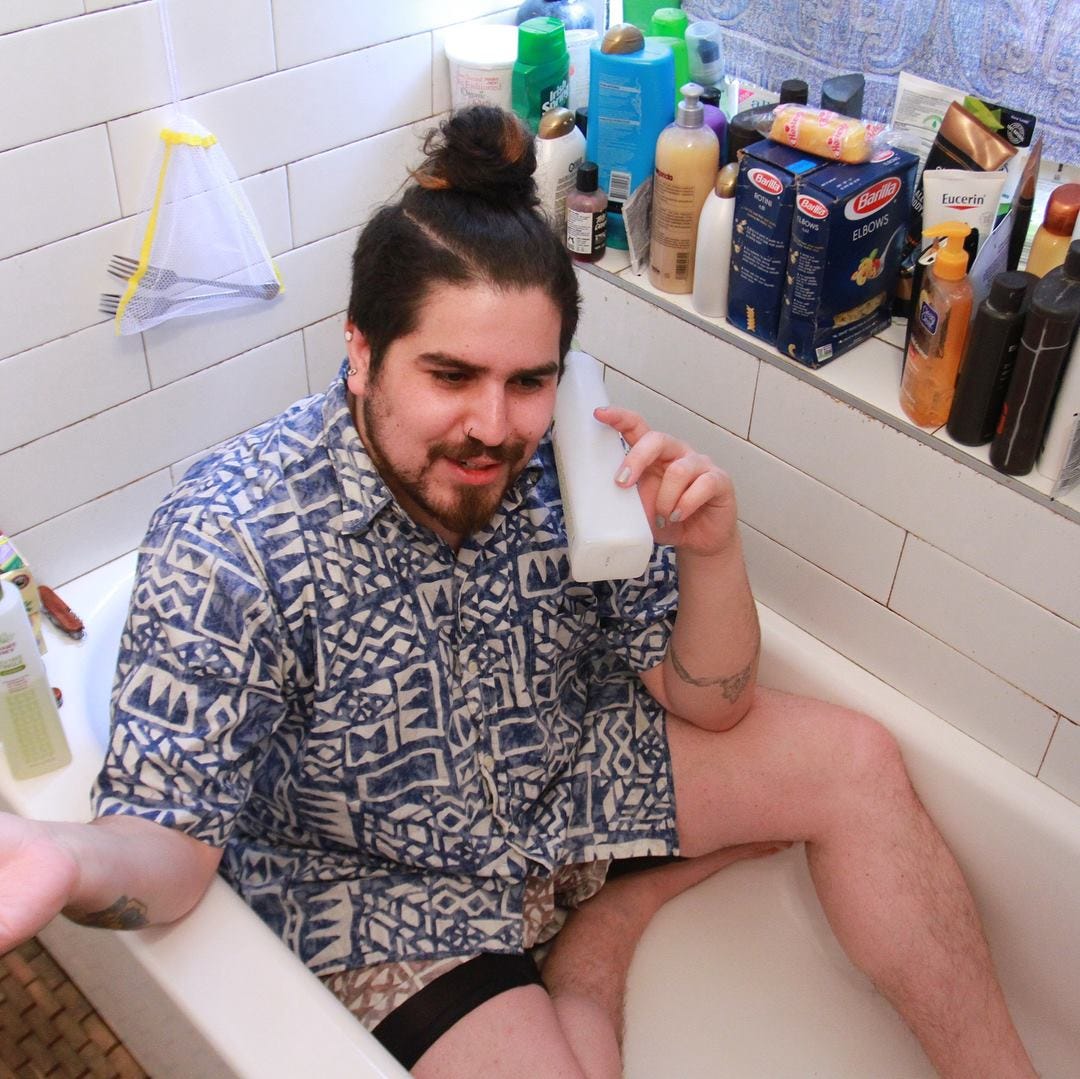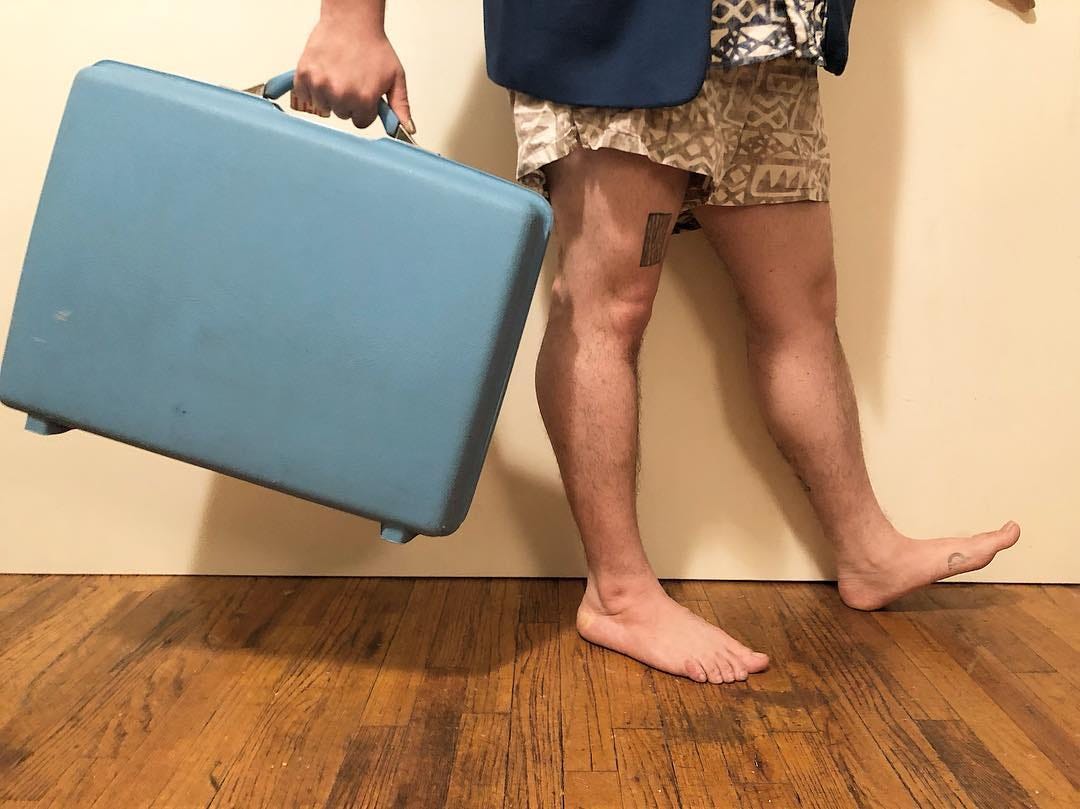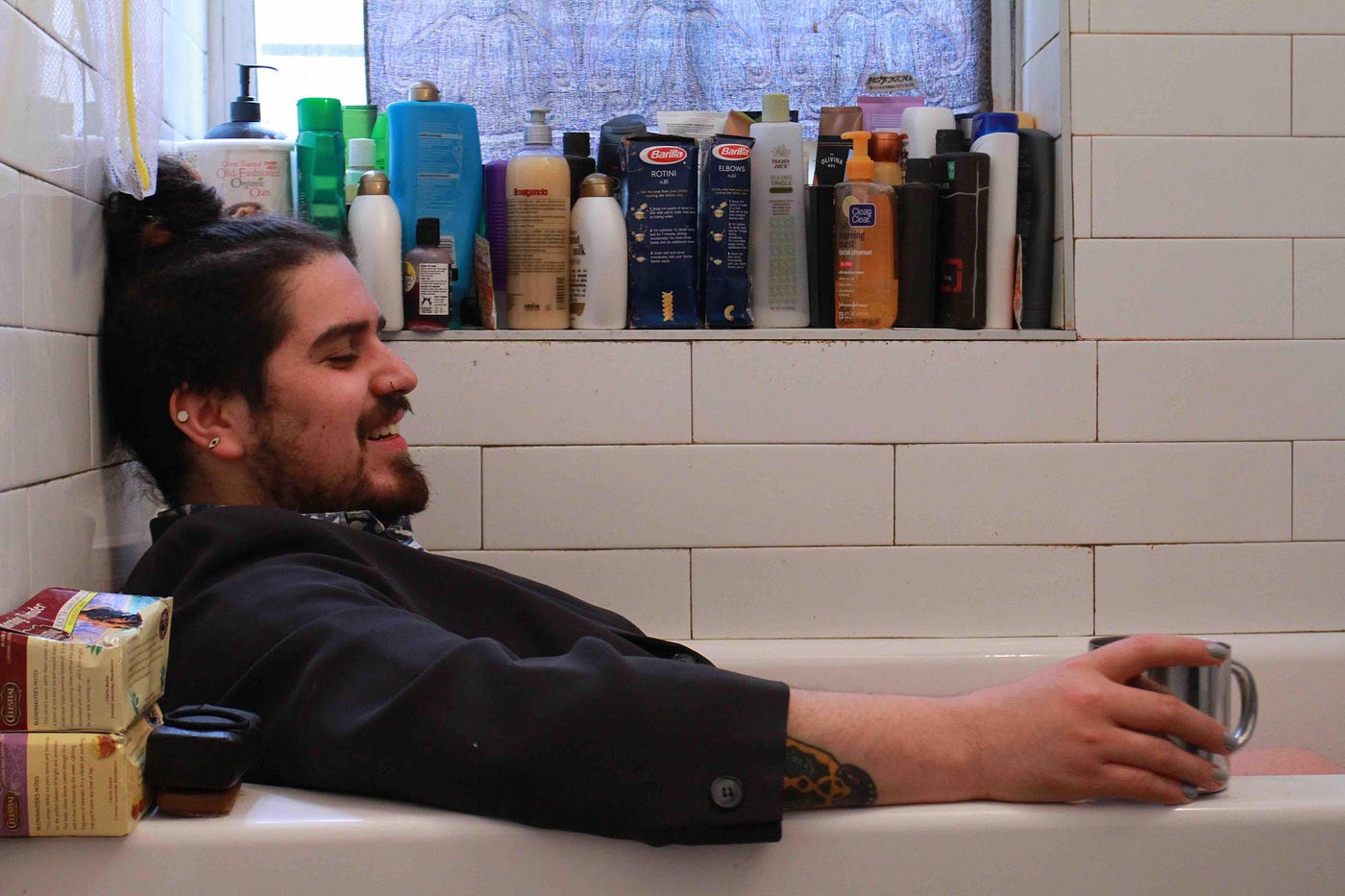
There’s a man in the bathtub. But it’s not just any bathtub, it’s NoPro writer Edward Mylechreest’s bathtub.
We’re in his tidy Upper West Side apartment. Just me, Ed …and the man in Ed’s tub.
He’s sitting in his boxer shorts, drinking some hot tea out of a camping mug. The man offers us some Cup O’ Noodles, but we politely decline. He goes on to explain that his diet these days consists mainly of pasta, instant ramen, and other foods that can be cooked with hot water. Because he lives in the tub.
It’s the only safe place to be.
You know, when the world ends.
In the End of the World Bar and Bathtub, a one-man show written and performed by Philip Santos Schaffer, the performer comes to you. More specifically: your bathtub.
The show works like this: the star of the show plus another staff member arrives at your front door with a suitcase of props and other essentials; there is an out-of-world segment of about 15 minutes as Philip sets up in the bathroom with the door closed. The two attendees make small talk with the staff member (in our case, Director Audrey Frischman) while this occurs. Audrey eventually checks in on Philip and gives us the signal that it is now time to enter.
We go into the bathroom and the show begins.

What follows is an hour-long interactive performance that feels more like a spontaneous conversation with a friend than anything else, but set against the backdrop of impending doom. Philip attempts to explain his belief that the world is coming to an end tomorrow (with some very vague reasons) and that the bathtub is surely the safest place to be when the apocalypse does happen (which is entirely reasonable). We have some genuine and authentic moments as the three of us hang out in the bathroom for the better part of an hour. There’s some banter about life in the bathtub, discussion of his chosen diet, reminiscing about his childhood and his family, pondering what life will be like after the end of the world, discussing what knowledge to pass onto humanity to come, and also some roleplaying. To call The End of the World Bar and Bathtub just a “show” seems inaccurate, because it’s far more than that.
However, the experience has a big foundational challenge which it doesn’t quite get right—where the world of the story begins and where it ends. Indeed, it is difficult to create a “magic circle” out of a bathroom, for sure; doubly so, when the host knows subconsciously it is not Philip’s bathroom, but rather his own bathroom in his own home. Compare this situation to a show like Broken Bone Bathtub, where participants arrive at a home to experience the show, but it is not their home. Additionally, part of the Broken Bone Bathtub conceit is that the protagonist needs to use other people’s bathtubs due to her injury, as she doesn’t have a bathtub at home. No such in-world logic is given here and The End of the World Bar and Bathtub struggles to communicate to its guests that we’re entering the fiction now, and it is now safe to leave the norms, roles, and rules of our normal lives behind us. Without some sort of a “journey” to arrive at the place where the show takes place, we’re on shaky ground when asked to believe that this is Philip’s bathroom and Philip’s home, when subconsciously we know it’s not.
Get Kathryn Yu’s stories in your inbox
Join Medium for free to get updates from this writer.
SubscribeSubscribe
The best of experience designers still rely upon a liminal space to make this transition: a literal tunnel, or a waiting room, or some other porthole to communicate that you will cross a threshold into the place they’ve created. You might be familiar with an in-between space like the Manderley Bar at the McKittrick Hotel or the waiting room at Then She Fell. Disney even does this at their theme parks — often without the participants sensing it consciously — as park goers travel through a tunnel to enter one of the theme parks. I’ve even seen this “crossing” done without a physical traversal: by having the audience close their eyes as someone else makes the smallest changes to lighting, sound, and decor, or as an audience member listens to something on headphones, eyes closed, with a soundtrack that gradually fades away. Thus, when you open your eyes again, you feel as if you are somewhere new. There’s some kind of transformation. Without fully enclosing a true magic circle around the experience, The End of the World Bar and Bathtub begins already a bit off-kilter.
It’s also a little ambiguous who we are to Philip (old friends?); we haven’t necessarily been “cast” into a specific part. Early on, he confesses that most of his friends and family have abandoned him due to his reclusive behavior and insistence that doom is nearly upon us. So then who am I to him? Who is he to us? How did we end up here? He asks some personal questions that wouldn’t necessarily make sense if we were already good friends; much of the experience is about him getting to know us. Based upon his certainty that the world will end tomorrow, I’m also unsure if his character is supposed to telegraph some sort of mental illness to the audience or not. Philip’s persona seems genuine but guarded; he never seems all that vulnerable despite being in the tub.
Speaking of which, the role the audience are to play in the piece doesn’t become clearer until later, and neither does the underlying power structure of the work.

Spoiler alert: Philip must choose one of the two attendees to join him in the bathtub, while the other, due to these unfortunate circumstances, will die. The ensuing contest lands somewhere between a Survivor tribal council and a beauty pageant. With a show that specifies an audience of exactly two people, this setup likely means pitting romantic partners or roommates or very good friends against one another. It’s like the world’s oddest job interview. (And again: how exactly did we become the two folks to choose from?) While some may relish having this “competition” foisted upon them, I felt as if this were an unsatisfying twist, one I had neither the ability to opt in to or opt out of. We had no choice as to where the story was going to go—he was going to pick one of us to get in the bathtub and only one of us. The ending of this particular story felt inevitable.
The result is some unlikely bedfellows: a story that is essentially “on rails” with a very high level of participation where it feels like the audience has a high level of influence, but where the person in the bathtub actually holds all the power. Philip continually has to re-steer the conversation back onto the intended track, always leading up to a choice where one person lives and the other dies. I noticed he was rushing his monologues towards the end of the show, as we had taken too many conversational tangents along the way. But the segues back into the pre-scripted material were a bit obvious and felt awkward. (It’s hard not to compare to how well a different bathtub-centric performer does this with much more grace and ease.)
Immersive/interactive creators often choose to lean into emergent audience behavior, recognizing that it is often far more interesting than what they might have devised on their own. These makers prize the spontaneity and deep engagement from the attendees who’ve truly bought into the world being created. Good immersive and interactive performers are able to gently re-direct and work audience members way back onto the main path when needed, often without the audience realizing what is happening. So much of this kind of performance relies on “yes, and” techniques and thinking on your feet — a true willingness to embrace spontaneity. That’s the magic of immersive: these serendipitous moments. But the current incarnation of this particular piece seems orthogonal with where the audience may wish to go. And though we might always be on rails at many immersive experiences, other shows do a better job of hiding those rails. The illusion of agency is sometimes more satisfying than actual agency.

The End of the World Bar and Bathtub is an interesting concept with a lot of potential. Who wouldn’t want a show to come to them, after all? There are some charming moments along the way and the performer is someone who is, well, an interesting person. I’d be glad to grab a drink with him outside of this context. But there are fundamental design decisions which hinder The End of the World Bar and Bathtub’s success as an immersive, interactive experience. I do hope these can be resolved after a good, hard look in the (bathroom) mirror.
If so, perhaps I’ll see Philip in the tub again, at some point, as we come again to the end of the world.
The End of the World Bar and Bathtub continues by appointment only, at a bathtub near you. Performances are $100 for audiences of exactly two—no more, no fewer.
NoPro is a labor of love made possible by our generous Patreon backers. Join them today!
In addition to the No Proscenium web site, our podcast, and our newsletters, you can find NoPro on Twitter, Facebook, YouTube, Instagram, in the Facebook community Everything Immersive, and on our Slack forum.
Office facilities provided by Thymele Arts, in Los Angeles, CA.




















Discussion